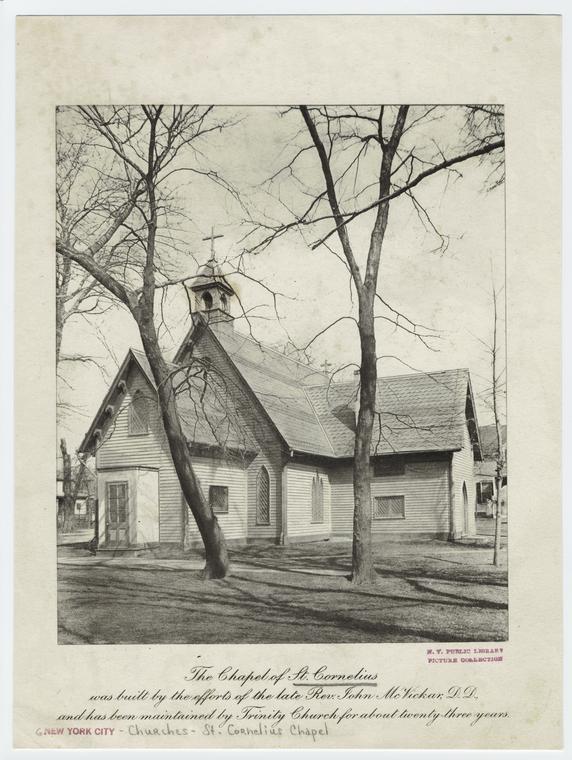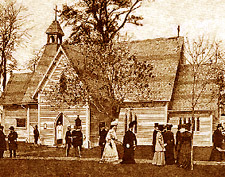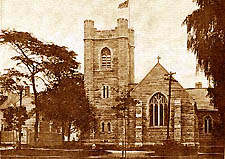The Chapel of St. Cornelius.
 New York, N.Y.
Notes:
Printed on border:
"...was built by the efforts of the late Rev. John McVickar, D.D.,
and has been maintained by Trinity Church for about twenty-three years."
Black spots on image.
Digital ID: 801032
NYPL Call Number: PC NEW YC-Chu-(A-Z)
New York, N.Y.
Notes:
Printed on border:
"...was built by the efforts of the late Rev. John McVickar, D.D.,
and has been maintained by Trinity Church for about twenty-three years."
Black spots on image.
Digital ID: 801032
NYPL Call Number: PC NEW YC-Chu-(A-Z)
 In 1844 when the Rev. Dr. John McVickar was appointed the island’s chaplain,
he found that what religious services took place there were conducted open
air or in temporary shelter if forced by weather conditions.
McVickar, who served as chaplain until 1862 when he retired at age 75, was
a scholar by nature but also proved himself a man of action when need for
that arose. A professor of moral philosophy, literature, and political
economy at Columbia College and author of several serious tomes, Chaplain
McVickar enlisted support for the island chapel project from Trinity Church
and its wealthy and powerful members. Major Gen. Winfield Scott, chief of the
Army, made 150 square feet on the south side of the pre-landfill island
available for leasing as a church site.
The wooden structure was dedicated April 19, 1847. Nearly six decades later
Oct. 17, 1906, the present granite, 14th Century English Gothic building,
designed by architect Charles C. Haight, a Civil War veteran, was dedicated.
Its site is not far from the wooden original’s site. The chapel’s electronic
chimes were installed in 1949 as a gift of the garrison.
When opened to the public, the chapel may display some artifacts of the
island’s history including reputedly the oldest U.S. Army flag in existence
and perhaps a copy of Chaplain Edmund Banks Smith’s 1913
Governors Island: Its Military History Under Three Flags.
In 1844 when the Rev. Dr. John McVickar was appointed the island’s chaplain,
he found that what religious services took place there were conducted open
air or in temporary shelter if forced by weather conditions.
McVickar, who served as chaplain until 1862 when he retired at age 75, was
a scholar by nature but also proved himself a man of action when need for
that arose. A professor of moral philosophy, literature, and political
economy at Columbia College and author of several serious tomes, Chaplain
McVickar enlisted support for the island chapel project from Trinity Church
and its wealthy and powerful members. Major Gen. Winfield Scott, chief of the
Army, made 150 square feet on the south side of the pre-landfill island
available for leasing as a church site.
The wooden structure was dedicated April 19, 1847. Nearly six decades later
Oct. 17, 1906, the present granite, 14th Century English Gothic building,
designed by architect Charles C. Haight, a Civil War veteran, was dedicated.
Its site is not far from the wooden original’s site. The chapel’s electronic
chimes were installed in 1949 as a gift of the garrison.
When opened to the public, the chapel may display some artifacts of the
island’s history including reputedly the oldest U.S. Army flag in existence
and perhaps a copy of Chaplain Edmund Banks Smith’s 1913
Governors Island: Its Military History Under Three Flags.
 When the Army operated Governor’s Island as Fort Jay, a Revolutionary fortification
of New York harbor, and long before there were military chaplains there, Trinity Parish
had taken upon itself the ministry to the religious needs of the island’s Army residents.
Before the advent of ferry boat service, every Sunday a priest would row the quarter
mile from the Battery to the Island, struggling with the heavy cross currents of the
East and Hudson Rivers. After two wooden chapels burned down, Trinity built a
beautiful stone chapel, which they also supported with clergy, maintenance, and
program funds.
The Army finally brought in its own Chaplains, but the other support continued
until the Coast Guard finally left the island. . . . Episcopal chaplains assigned
there were considered ex-officio members of Trinity Parish.
Back To MANHATTAN CHURCH PHOTOS Main Index
Back To MANHATTAN Main
Back To WORSHIP Main
Back To BROOKLYN Main
When the Army operated Governor’s Island as Fort Jay, a Revolutionary fortification
of New York harbor, and long before there were military chaplains there, Trinity Parish
had taken upon itself the ministry to the religious needs of the island’s Army residents.
Before the advent of ferry boat service, every Sunday a priest would row the quarter
mile from the Battery to the Island, struggling with the heavy cross currents of the
East and Hudson Rivers. After two wooden chapels burned down, Trinity built a
beautiful stone chapel, which they also supported with clergy, maintenance, and
program funds.
The Army finally brought in its own Chaplains, but the other support continued
until the Coast Guard finally left the island. . . . Episcopal chaplains assigned
there were considered ex-officio members of Trinity Parish.
Back To MANHATTAN CHURCH PHOTOS Main Index
Back To MANHATTAN Main
Back To WORSHIP Main
Back To BROOKLYN Main



